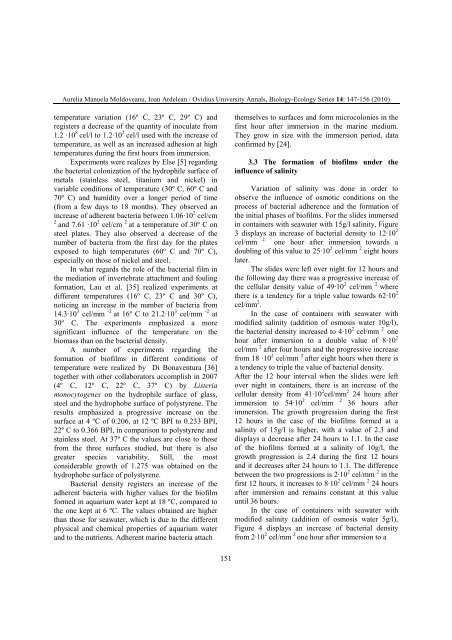VOLUM OMAGIAL - Facultatea de Ştiinţe ale Naturii şi Ştiinţe Agricole
VOLUM OMAGIAL - Facultatea de Ştiinţe ale Naturii şi Ştiinţe Agricole
VOLUM OMAGIAL - Facultatea de Ştiinţe ale Naturii şi Ştiinţe Agricole
You also want an ePaper? Increase the reach of your titles
YUMPU automatically turns print PDFs into web optimized ePapers that Google loves.
Aurelia Manuela Moldoveanu, Ioan Ar<strong>de</strong>lean / Ovidius University Annals, Biology-Ecology Series 14: 147-156 (2010)<br />
temperature variation (16º C, 23º C, 29º C) and<br />
registers a <strong>de</strong>crease of the quantity of inoculate from<br />
1.2 ∙10 8 cel/l to 1.2∙10 2 cel/l used with the increase of<br />
temperature, as well as an increased adhesion at high<br />
temperatures during the first hours from immersion.<br />
Experiments were realizes by Else [5] regarding<br />
the bacterial colonization of the hydrophile surface of<br />
metals (stainless steel, titanium and nickel) in<br />
variable conditions of temperature (30º C, 60º C and<br />
70º C) and humidity over a longer period of time<br />
(from a few days to 18 months). They observed an<br />
increase of adherent bacteria between 1.06∙10 2 cel/cm<br />
2 and 7.61 ∙10 2 cel/cm 2 at a temperature of 30º C on<br />
steel plates. They also observed a <strong>de</strong>crease of the<br />
number of bacteria from the first day for the plates<br />
exposed to high temperatures (60º C and 70º C),<br />
especially on those of nickel and steel.<br />
In what regards the role of the bacterial film in<br />
the mediation of invertebrate attachment and fouling<br />
formation, Lau et al. [35] realized experiments at<br />
different temperatures (16º C, 23º C and 30º C),<br />
noticing an increase in the number of bacteria from<br />
14.3∙10 3 cel/mm -2 at 16º C to 21.2∙10 3 cel/mm -2 at<br />
30º C. The experiments emphasized a more<br />
significant influence of the temperature on the<br />
biomass than on the bacterial <strong>de</strong>nsity.<br />
A number of experiments regarding the<br />
formation of biofilms in different conditions of<br />
temperature were realized by Di Bonaventura [36]<br />
together with other collaborators accomplish in 2007<br />
(4º C, 12º C, 22º C, 37º C) by Listeria<br />
monocytogenes on the hydrophile surface of glass,<br />
steel and the hydrophobe surface of polystyrene. The<br />
results emphasized a progressive increase on the<br />
surface at 4 ºC of 0.206, at 12 ºC BPI to 0.233 BPI,<br />
22º C to 0.366 BPI, in comparison to polystyrene and<br />
stainless steel. At 37º C the values are close to those<br />
from the three surfaces studied, but there is also<br />
greater species variability. Still, the most<br />
consi<strong>de</strong>rable growth of 1.275 was obtained on the<br />
hydrophobe surface of polystyrene.<br />
Bacterial <strong>de</strong>nsity registers an increase of the<br />
adherent bacteria with higher values for the biofilm<br />
formed in aquarium water kept at 18 ºC, compared to<br />
the one kept at 6 ºC. The values obtained are higher<br />
than those for seawater, which is due to the different<br />
physical and chemical properties of aquarium water<br />
and to the nutrients. Adherent marine bacteria attach<br />
151<br />
themselves to surfaces and form microcolonies in the<br />
first hour after immersion in the marine medium.<br />
They grow in size with the immersion period, data<br />
confirmed by [24].<br />
3.3 The formation of biofilms un<strong>de</strong>r the<br />
influence of salinity<br />
Variation of salinity was done in or<strong>de</strong>r to<br />
observe the influence of osmotic conditions on the<br />
process of bacterial adherence and the formation of<br />
the initial phases of biofilms. For the sli<strong>de</strong>s immersed<br />
in containers with seawater with 15g/l salinity, Figure<br />
3 displays an increase of bacterial <strong>de</strong>nsity to 12∙10 2<br />
cel/mm 2 one hour after immersion towards a<br />
doubling of this value to 25∙10 2 cel/mm 2 eight hours<br />
later.<br />
The sli<strong>de</strong>s were left over night for 12 hours and<br />
the following day there was a progressive increase of<br />
the cellular <strong>de</strong>nsity value of 49∙10 2 cel/mm 2 where<br />
there is a ten<strong>de</strong>ncy for a triple value towards 62∙10 2<br />
cel/mm 2 .<br />
In the case of containers with seawater with<br />
modified salinity (addition of osmosis water 10g/l),<br />
the bacterial <strong>de</strong>nsity increased to 4∙10 2 cel/mm 2 one<br />
hour after immersion to a double value of 8∙10 2<br />
cel/mm 2 after four hours and the progressive increase<br />
from 18 ∙10 2 cel/mm 2 after eight hours when there is<br />
a ten<strong>de</strong>ncy to triple the value of bacterial <strong>de</strong>nsity.<br />
After the 12 hour interval when the sli<strong>de</strong>s were left<br />
over night in containers, there is an increase of the<br />
cellular <strong>de</strong>nsity from 41∙10 2 cel/mm 2 24 hours after<br />
immersion to 54∙10 2 cel/mm 2 36 hours after<br />
immersion. The growth progression during the first<br />
12 hours in the case of the biofilms formed at a<br />
salinity of 15g/l is higher, with a value of 2.3 and<br />
displays a <strong>de</strong>crease after 24 hours to 1.1. In the case<br />
of the biofilms formed at a salinity of 10g/l, the<br />
growth progression is 2.4 during the first 12 hours<br />
and it <strong>de</strong>creases after 24 hours to 1.1. The difference<br />
between the two progressions is 2∙10 2 cel/mm 2 in the<br />
first 12 hours, it increases to 8∙10 2 cel/mm 2 24 hours<br />
after immersion and remains constant at this value<br />
until 36 hours.<br />
In the case of containers with seawater with<br />
modified salinity (addition of osmosis water 5g/l),<br />
Figure 4 displays an increase of bacterial <strong>de</strong>nsity<br />
from 2∙10 2 cel/mm 2 one hour after immersion to a





